Church of St. Nicola, village of Gradeshnica
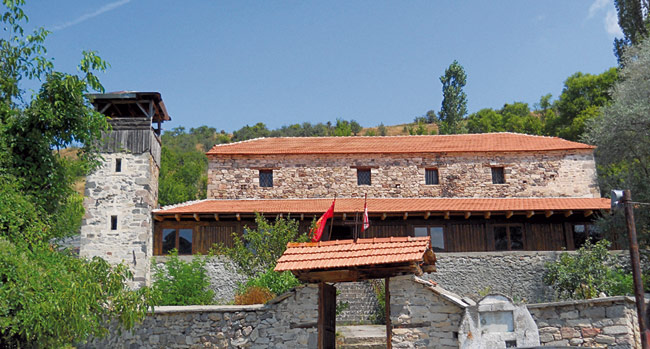
At the end of the XVIII and early XIX century, major political, social and economic changes occurred in the Ottoman Empire as a result of the military defeats that drove the country into economic and political dependence on the European countries.
In that period, Macedonia still has been an integral part of the spacious Rumeli vilayet, with the center in Sofia, that has been transferred to Bitola soon due to military, strategic and political reasons.
More benefits to the Christian population under the Ottoman ruling have been approved with the Peace Treaty from Edirne in 1828 and the Treaty between Russia and Turkey from 1830.
With the release of Turkey's top government decree Gjulahan hatisherif from 1839 for the first time the Sultan Abdul Mecit proclaimed full equality before the law for all citizens regardless of religion, ethnicity and social status. These reforms opened a permanent process of political, socio-economic and cultural trends and in this context, a new social progress.
The impact of social relations will be felt mostly on spiritual, cultural, educational and artistic plan. With the abolition of the autonomy of the Ohrid Archbishopric, Constantinople Patriarchate became conductor of Greek influence, the Bulgarian Exarchate of Bulgarian influence, later on Serbian also, standing against the initiatives of the Macedonian population in terms of its economic and cultural upbringing. But, despite everything, in the nineteenth century the so-called revival period was ongoing in Macedonia that was still within the Ottoman Turkey; but larger process was also present in Macedonia - Industrial revolution that was taking place in Europe. In the period of revival increased activity of restoration of churches and monasteries started in Macedonia. Construction activity for the needs of Christian population was intensified, too.
Architecture, painting, carving, begin to fully manifest the psychological characteristics of the times and the new life, and its expression - the spiritual atmosphere of the era. With increased economic empowerment of Macedonian element construction of larger and higher religious buildings - churches of solid material began. They begаn to be built in a distinctive architectural style of the XIX century, with large basilica disposition, which represent high technical achievement for the period when built.
The village of Gradeshnica also continued its building tradition during the XIX century. In that period in the village of Gradeshnica was built such a religious building in the center of the village.
It is the church of St. Nicholas, which we learn from the inscription of the founder that the temple was built in 1862. Twenty years later, the church was wall-painted.
In 1918, during the World War I the church suffered major destruction. There are opinions that the XIX century church was built on the foundations of an older one. In order to confirm or refute this thesis, it is necessary to carry out extensive research including the archaeological. But it is known that the church as well as many other facilities in the village suffered severe damage during the World War I, i.e. in 1918. Because of that, renovations were carried out on the architecture in 1923, a wall painting was restored in 1927, in the upper zones of the aisles and central nave. These damaged areas were re-painted by Costa Nikolikj with his sons, Jakim and Theodosia, originating from Lazaropole, during Metropolitan Joseph of Bitola. More recently additional restoration has been performed to the roof and porches from the west and the south side of the church.
In the period from 1881 to 1893, the Debar zografs, students and followers of Dicho Zograf, led by his son Avram (Abraham), painted some revival churches in Mariovo; in their painting program common composition with figures of St. Cyril and St. Methodius will be present.
Although the signature of Avram Dichov is found only in the monastery church St. Elijah (St. Ilija) in the village of Melnica, whose paintings are dated in 1881, this painters’ group can be attributed several painted churches in Mariovo. Among the generation of painters, students and followers of Dicho Zograf, whose painting program encompasses the figures of St. Cyril and St. Methodius, are the brothers Josif and Jacov Radevikj, originating from Miak village of Lazaropole, of family of Mazhovski. Their wall-painting activity was especially fruitful in the last quarter of the XIX century in the region of southwestern and northern Macedonia. More plausible is that painting group of brothers Josif and Jakov Radevikj was engaged for painting the church of St. Nikola in the village of Gradeshnica.
Church of St. Nicholas is stone construction combined with lime mortar with dimensions of 18.60 x 12 m. and a height of 7.87 m. The construction of the church is the type of basilicas or so-called pseudo-basilicas that are characteristic of revival period in Macedonia. On the south side there are surrounding walls of stone, where the main entrance - a wooden gate is. There is a fountain from the right side of the gate. Entrance to the church is on the west side which leads to the narthex and there is another entrance on the south side through which you enter in the nave of the church. On the northwest side of the west wall above the narthex there is a floor gallery that is reached by wooden stairs. The gallery above the narthex is a rectangular base, which is close towards the nave i.e. surrounded by a fence of 1m in height.
Naos of the church is divided into three naves with two columns of five pillars. On the top of the pillars there are capitals over which arches are built dividing the flat ceiling in parts. The Old Testament Prophets are painted on the wall surfaces above the arches on north and south. Middle part is the highest. Central and side parts are colored with light blue color, as an imitation of the sky and on the surface of the central part gold stars are painted. In the center of the middle part there is a canvas portraying Jesus Christ Almighty.
Main entrance to the nave is on the south wall of the church. Above the door there is a semicircular concave niche where the bust St. Nicholas the Wonderworker is painted. On the west side there is another entry to the church with semicircular concave niche above the door. In the niche bust of St. Athanasius is painted. Probably patron of the older church was St. Athanasius. On the east altar with central apse is shaped, which is semicircular inside and seven-angled outside. On both sides of the apse two semicircular niches with semicircular bases are built.
Porches are built on the west and south side; the roof of the church is on the two slopes, covered with red tiles, while the apse is covered with thin stone slabs of slate. The facade of the church worked with polished joints. Stone is the constructing material mainly used for wall surfaces paired with mortar and wood for the roof structure. The bell tower is near the church i.e. attached to the south porch. Along the north and the south nave wall wooden seats are placed for the believers, but also in the inter-space of the colonnades of the north and south.
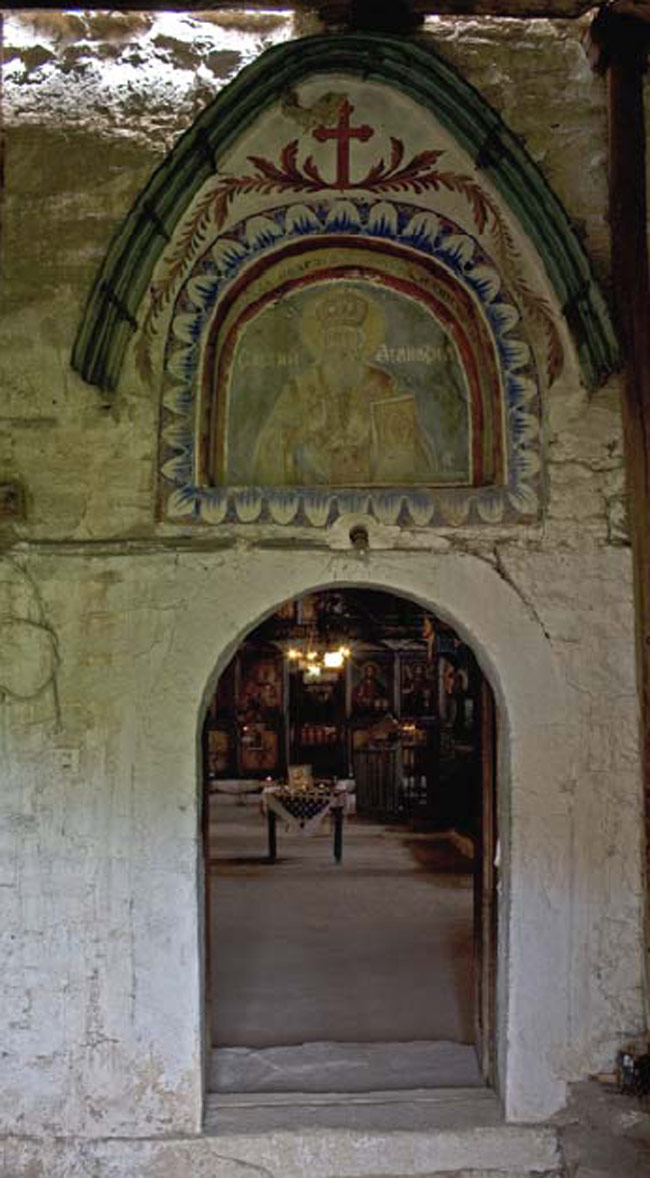
Niche above the entrance on the west side portraying St. Athanasius
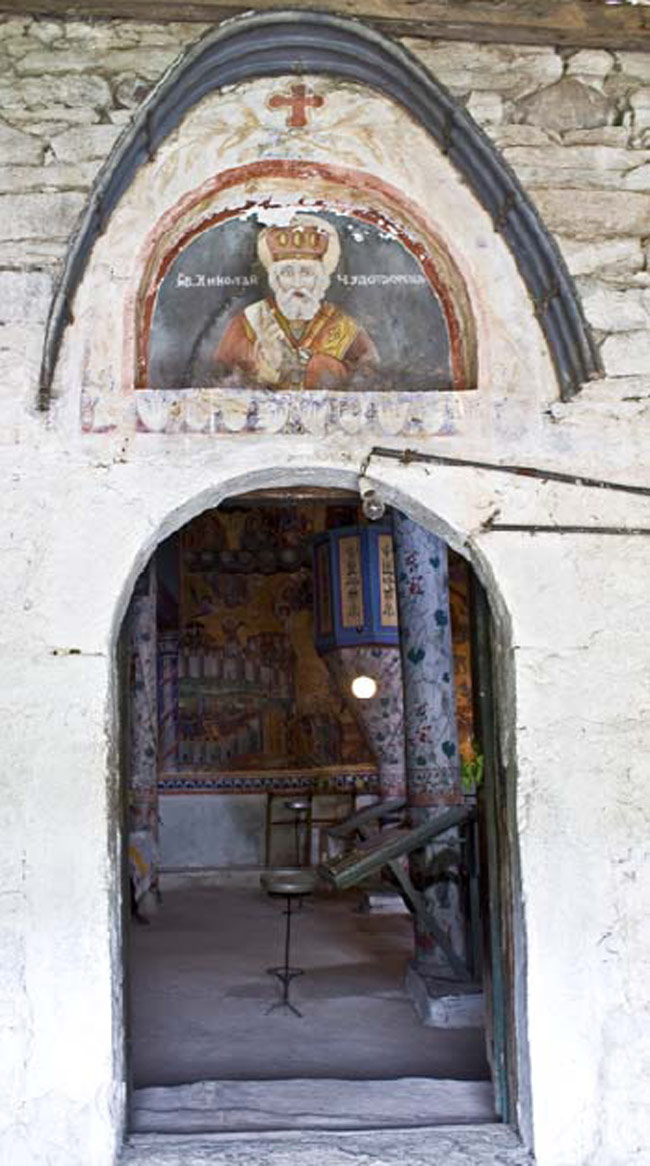
Niche above the entrance on the south side portraying St. Nicholas
Wooden iconostasis decorated with icons is placed on the east side. Between the south colonnade bishop’s throne is set that is made of wood and painted with floral motifs; inside an icon of Jesus Christ on the throne is painted. Between the north colonnade the pulpit is placed which is painted with floral motifs. The columns and capitals are painted with white lime paint and decorated with motifs of the vine and grape and also floral arrangements. Iconostasis which separates the nave from the altar is decorated with icons; some fields are painted mostly with floral motifs in the so-called local Baroque style. In the lower part of the iconostasis the holy gates portraying the Annunciation are placed centrally, and the left and right are deployed four rectangular plates on which are painted vases with floral bouquets. In the first zone and in the zone where the throne icons are displayed there is a door that leads to prothesis depicting the Archangel Michael and the door leading to diaconicum Saint Spyridon is painted. Throne icons of the second area are large and they are arranged to north the south in the following order: St. Kyriake, St. Three Hierarchs, St. Nicholas, Theotokos with Jesus Christ, Jesus Christ Almighty, St. John the Baptist and other saints.
In the third zone icons of smaller format are set, in the middle a variant of Deisis is set with individual icons of Jesus Christ, the Virgin Mary and St. John the Baptist.
South and north along the iconostasis 12 apostolic icons are placed. Centrally, on the top of the iconostasis called Grand Cross or Cross Serpents is set, the stand of two dragons and two smaller side icons. The iconostasis of the wooden pillars, corners, is decorated with floral motifs, and the horizontal plank between the throne and the apostolic icons is decorated with branches of the vine and grape that rhythmically repeat. The icons of the iconostasis most probably we can assume the group of brothers Josif and Jakov Radevikj. Signatures are written in church Slavic language. In decorating the wall surfaces and icons of the nineteenth century temples mostly bright colors prevail and minimum academic realism begins to appear, leaving the ancient technique and technology of the Byzantine style of painting.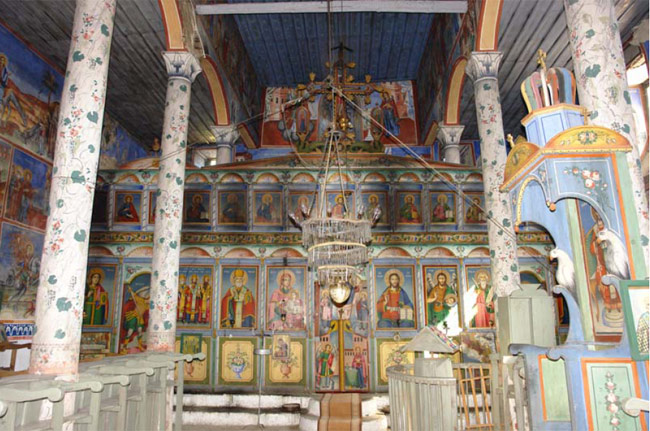
View of the church to the east

View of the church to the west
Spaciousness of the church permits the iconographic program to be deployed is a classic way, with inserted compositions typical for the period of the XIX century. The church is painted in the sanctuary, the north and the south wall of the nave, the wall surfaces of the porches, surfaces formed by arches of the colonnade of pillars in the nave. Compositions mostly from the New Testament, Old Testament, Holidays and Christ’s Passions, holy warriors and martyrs etc. are painted. In the sanctuary the Virgin Mary Oranta and Jesus Christ Emmanuel are painted; Jesus Christ Emmanuel is placed in a circular Aureola on the breast of Theotokos. Above this scene there is an inscription of the time of painting the church or 1889.
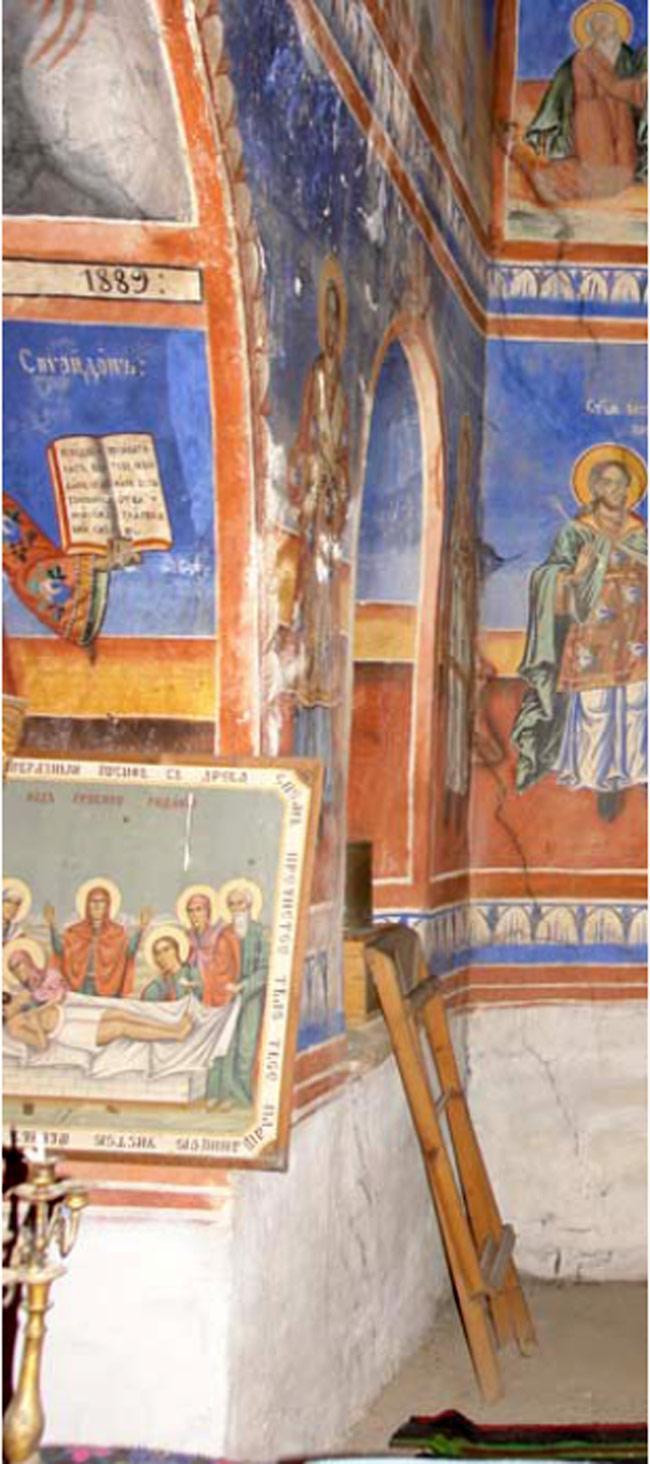
The year of the first phase of fresco painting of the church in the central apse of the sanctuary
In the lower zone the composition of Veneration of the Holy Hierarchs, and below the north and south of the eastern wall are represented the holy deacons Stephen, Roman, Melod and Cyril and other saints. In the sanctuary are presented Saints Cosmas and Damian Unmercenaries, St. Amnos, St. Panteleimon, and in the upper areas compositions of the life of Mary and the New Testament’s Holy Trinity.
Composition of Jesus Christ the Righteous Judge is painted on major part of the wall surface of the north wall of the nave and in continuation towards the east compositions of Jesus Christ’s life are painted in the second and third zone; in the first zone composition showing St. Cyril and St. Methodius is painted. We met the iconographic scene in which Jesus Christ blesses the Thessaloniki brothers not only in wall-painting of the church of St. Nikola in the v. of Gradeshnica, but also in the church of St. Paraskeve-Petka in the village of Zhivovo.
In this painting of this church from the revival period, the composition of St. Cyril and St. Methodius painted in Bishop’s vestment with miters on the heads. St. Cyril is depicted as a middle-aged man with dark hair and beard, holding in the right hand archpriest’s scepter and with left hand, on the chests holding open the Gospel which is with the Slavic letters written text: the word of Christ .... St. Methodius is an old man with white hair and beard, with a cross in the right hand, raised high, and scroll with the alphabet in the left hand. Jesus Christ blessing with both hands is depicted over the brothers from Thessaloniki. As a template for shaping this composition of brothers from Thessaloniki probably a painted lithograph was used made in Vienna in 1864, by order of Hristo Danov and printed from Vienna Master Obenheiner. The template was used by Dico the zograf first while painting the icon which represented first Slavic teachers.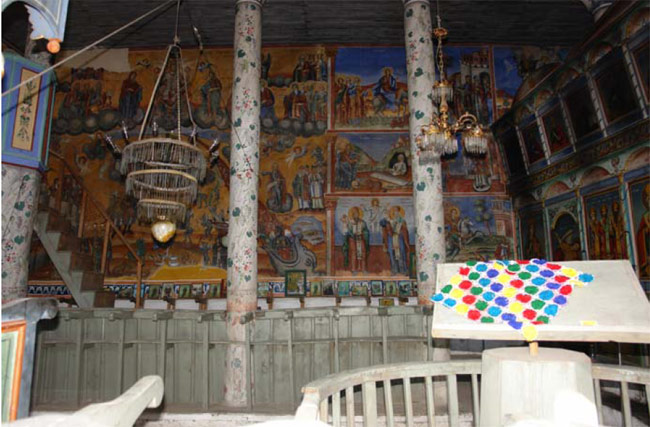
View the painting to the north side of the nave
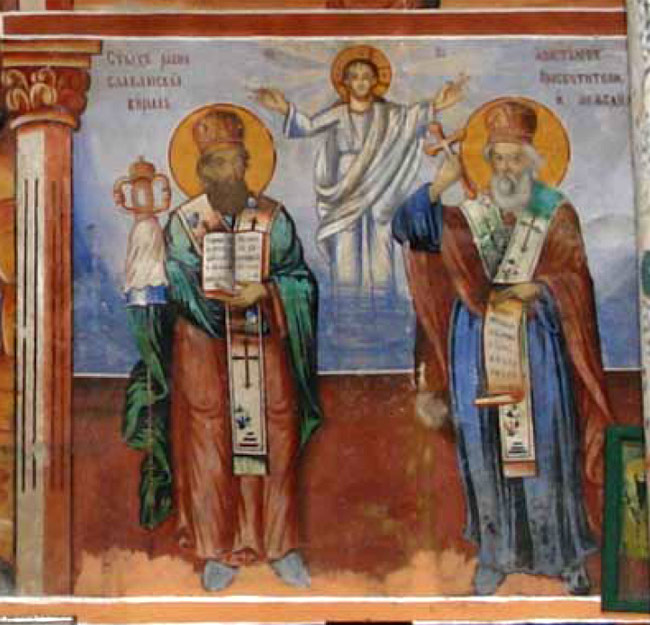
Pan-Slavic first teachers St. Cyril and St. Methodius presented in the second zone of the north wall of the nave
Holy warriors, other saints and martyrs in full growth are depicted on the south side of the nave in the first zone: starting from east to west St. Demetrius on horseback, St. Constantine and St. Helene, holy warriors: St. Nestor, St. Teodor Tyron and Stratilat, St. Menas, St. Mercurius, Archangel Gabriel and Archangel Michael, St. Christopher, St. Procopius, St. Gjorgji Dimovski.
In the second zone from east to west are represented: St. Triphon, above him St. Simeon Outpourer of Myrrh, scene with Serbian Archbishop Saint Sava and probably Saint Nicholas, the scene of Transfiguration of Christ, St. Catherine and St. Barbara.
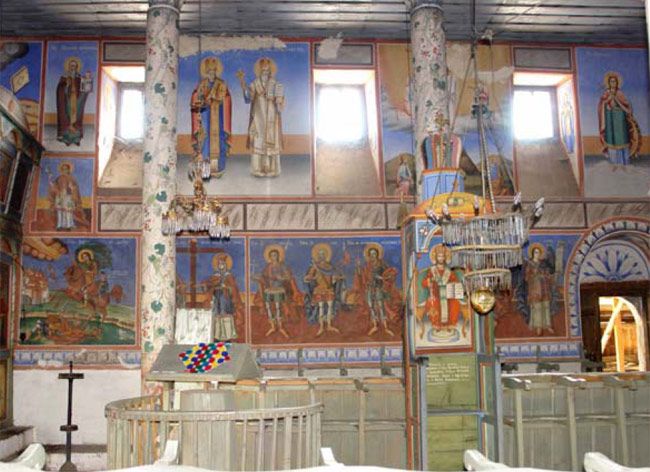
View to the painting to south wall in the nave
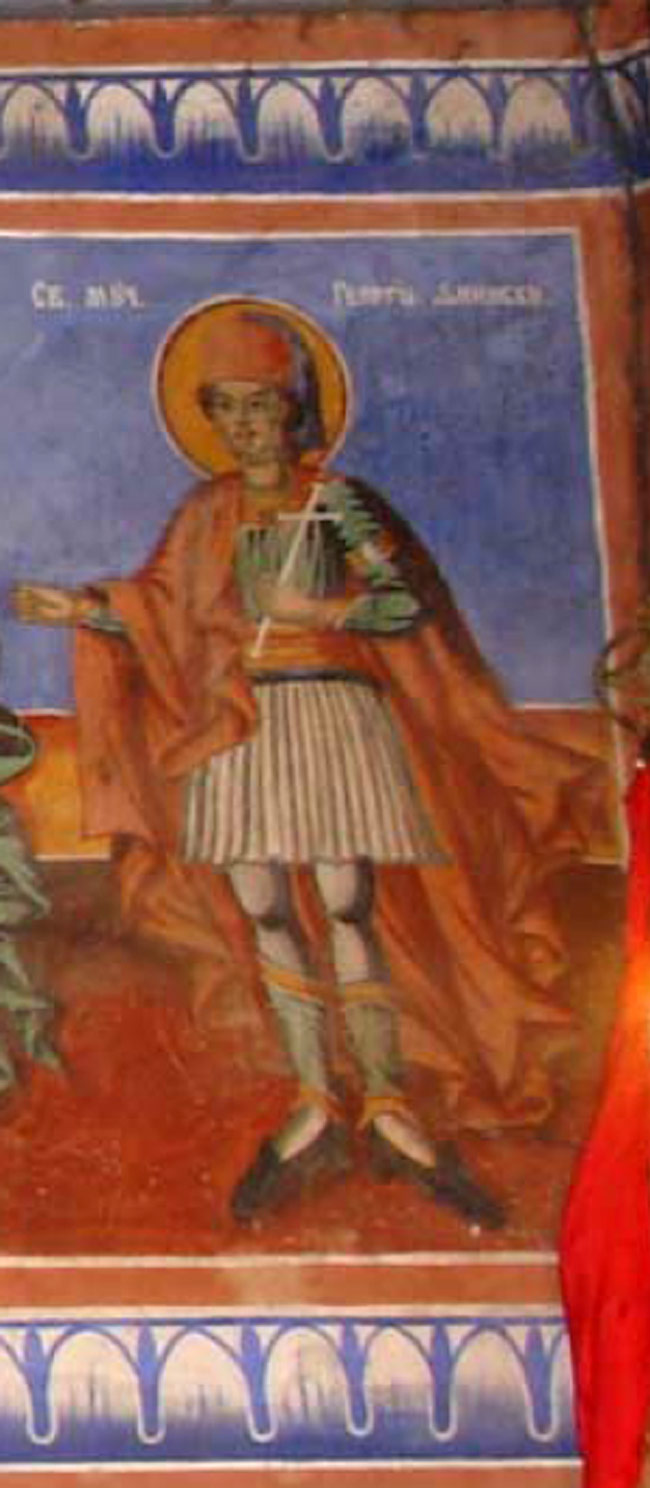
St. Gjorgji Dimovski, a local martyr, in the first zone of the south wall of the nave
On the west wall in the upper zone the composition Last Supper s painted.
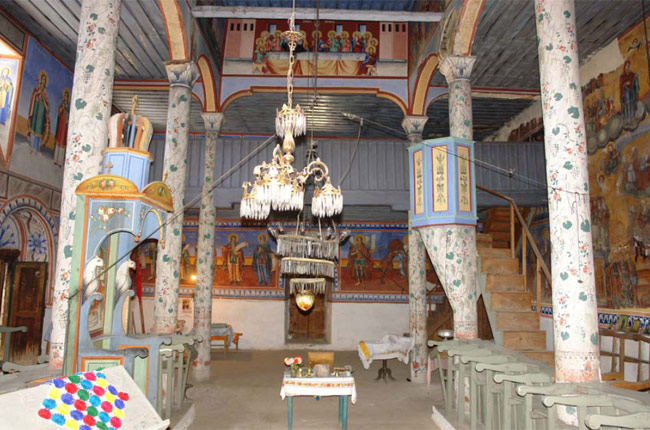
View to the west wall frescoes in the nave
On the south wall in the floor gallery painted the holy martyrs Eugenia and Theodora [are depicted], while on the western wall the Old Testament scenes and scenes of Hell.
St. Nicholas Church in the village Gradeshnica - Mariovo for its architecture and painting program is a typical example of the nineteenth century, revival, religious buildings in the territory of the Republic of Macedonia.
Text: Olivera Makrievska
NI Institute and Museum of Bitola









